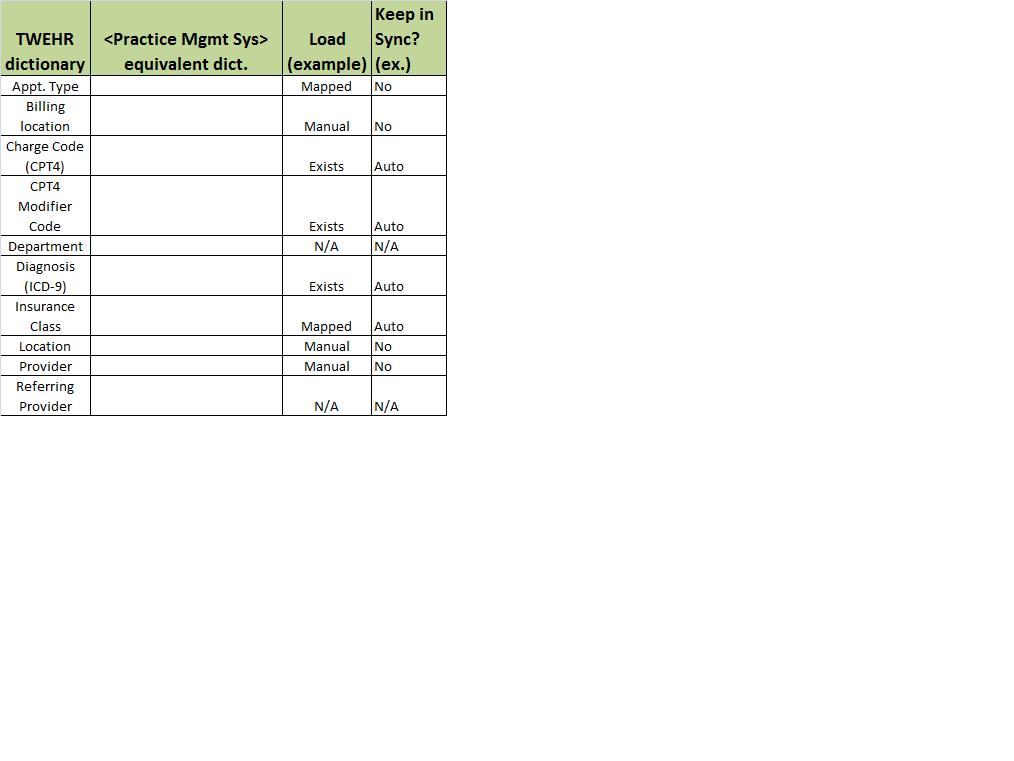Difference between revisions of "Bulk Load"
Steve.Stahr (talk | contribs) |
Steve.Stahr (talk | contribs) |
||
| Line 8: | Line 8: | ||
== Loading and syncing tables between PMS and TW == | == Loading and syncing tables between PMS and TW == | ||
| − | A table can be developed that identifies all relevant tables that will be communicating between the PMS and Touchworks. | + | A table can be developed that identifies all relevant tables that will be communicating between the PMS and Touchworks. A table can help layout what tables need to be addressed and what strategy will be applied for each. See below: |
[[Image:Dictionary mapping.jpg]] | [[Image:Dictionary mapping.jpg]] | ||
| − | |||
| − | |||
| − | |||
| − | |||
| − | |||
| − | |||
| − | |||
| − | |||
| − | |||
| − | |||
| − | |||
The equivalent table in the PMS needs to be identified. While a practice or Health Care Organization may have consistent Appointment Types, a multi-Org practice will likely not have the same values in many of the dictionaries. The options 1) add each practices values to the pertinent dictionary or 2) agree upon a set package of values in TW and map each PMS to that set. | The equivalent table in the PMS needs to be identified. While a practice or Health Care Organization may have consistent Appointment Types, a multi-Org practice will likely not have the same values in many of the dictionaries. The options 1) add each practices values to the pertinent dictionary or 2) agree upon a set package of values in TW and map each PMS to that set. | ||
Revision as of 16:47, 29 September 2008
Conducting the Bulk Loads
Once an interface between the Practice Management System and Touchworks is installed (via ConnectR), several sets of existing data are loaded into TouchWorks through a bulk-load process. Patient demographic, registration and scheduling are key data sets that sync the two systems. This data allows TouchWorks to display clinic schedules and builds a framework of basic patient data prior to their next visit. Having patient information already in the system enables the practice to pre-load already known records into TouchWorks. Commonly pre-loaded data is Problems, Immunizations, Medications, and Allergies (P.I.M.A.).
Charge dictionaries can be bulk loaded through the interface, but can also be loaded through the SSMT by the implementation team. The charge dictionaries include CPT, ICD-9, and modifiers. The options then available within TouchWorks will be specialized and in tandem with the values in the PMS. After the initial bulk load of charge dictionaries, necessary minor updates are typically made manually.
Loading and syncing tables between PMS and TW
A table can be developed that identifies all relevant tables that will be communicating between the PMS and Touchworks. A table can help layout what tables need to be addressed and what strategy will be applied for each. See below:
The equivalent table in the PMS needs to be identified. While a practice or Health Care Organization may have consistent Appointment Types, a multi-Org practice will likely not have the same values in many of the dictionaries. The options 1) add each practices values to the pertinent dictionary or 2) agree upon a set package of values in TW and map each PMS to that set.
Once mapped, it is now determined how the TW dictionary will get populated. This makes up the third column on the four column table. Possibilities include Manual entry, bulk-load, content already exists, or N/A. The final column identifies if/how that dictionary will stay in sync with the PMS. Options here include Manual entry (new user/provider), automatic (Allscript's Delta Process), or N/A for dictionaries that do not need to sync between the PMS and TW.
